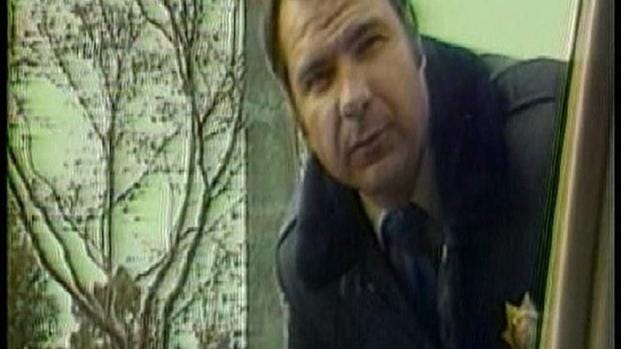Shortly before his death, I was helping my grandfather [Bampy] prune our fig tree when he asked me if I had noticed the little green house across the street from us and over the bridge that crossed the “Sankey”. The Sankey was a man-made irrigation creek built by Native Americans during the Spanish mission days. The correct spelling is “Zanja.”
I said, “Sure. It’s next to my friend’s house.”
“Well, keep an eye out whenever you play over there,” he said. “Something bad happened there.”
My grandfather Bampy had been the constable (Sheriff) in Redlands during and for a short time after World War II. He was a 4-letter athlete from high school and a 6-year college student at the University of Redlands: his kicking return record from the early 20th century still stands — or it did the last time I was in the gym at the U of R.

Bampy told me he had gotten a call to that house and he and one of the deputies, probably Dale Pence, went out there. When they knocked on the door they surprised the people inside.
“There was a man in there in bed with his daughters, two young girls about your age,” Bampy said.
“We took him to jail and took the girls to Juvenile Hall.” I never saw Bampy angry. But his face was dark. There were clouds in his clear gray eyes.
I knew the man was bad. But I didn’t — and I was 12 at the time — know exactly why.
I knelt down to pick up fig branches and leaves. Bampy knelt close to me.
“That man used to be a police officer. Honey, I want you to understand something,” he said. “If you are ever stopped by a police officer and he asks you to do something that doesn’t sound right to you, he isn’t a real officer. Don’t do what he says.”
Sometimes I wonder if my own daughter has ever listened to a word I ever said. As to me, Bampy’s words and demeanor burned themselves into my mind. It has taken a long lifetime for me to understand their full impact and meaning.
After we worked a little bit more he added, “Once you can drive if you get pulled over and the officer asks you to get out of the car, don’t do it.”
By the time I was in college, Bampy had been gone for seven years.

I was on my own and probably not doing that great with managing what little money I had or my schooling. But I was going to work and class and sleeping at least 2–3 hours a night.
In 1981, we were on winter break and I was driving south on Interstate 15 to La Mesa to visit my boyfriend and his parents. I remember I had a pack of gum on the passenger seat in my VW Rabbit. I know I wasn’t speeding because the Rabbit topped out at a teeth-jarring 85 mph and even 70 MPH was too fast in that silver jalopy. I can’t remember what I was wearing — probably something Pete, who “dressed” me, wanted me to wear.
My heart just about jumped out of my chest when I saw the lights of a CHP cruiser flashing behind me.
I could barely breathe.
The CHP car directed me to pull off the freeway. We got off on an offramp that “led to nowhere” near a big tall bridge.

The officer got out of his car and came to the drivers’ side window.

He rapped on my window and gestured for me to roll it down. I did: about 5 inches the way Bampy had shown me.
“I know I wasn’t speeding officer,” I said.
He asked me to roll the window down more and turn off my engine.
“What did I do wrong?” I asked.
The officer peppered me with questions. Where did I live? Where was I going to? Did I have a job?
I told him I lived with my grandmother and was a college student on my way to visit my boyfriend and his family for the holidays (the truth).
Then he asked me to get out of my car.
I didn’t say anything or move for a few seconds. My mind was blank and my heart was hammering in terror. My hands were icy cold claws on the steering wheel. My red lacquered nails: oh, I was so vain of my hands and so proud of my fingernails.
I heard Bampy’s voice, “If an officer asks you to get out of the car there’s something wrong.”
“Don’t do what he says.”
He put one hand on top of my rolled down window and his other hand on the latch. He rattled the outer door latch.
Remember the locks in old cars? The ones you could pop with a coat hanger in a second? The Rabbit’s were red. A narrow red post with a small red knob on top. I had red nauga-pholstery.
Then hard survivor Amy kicked in. This wasn’t the first time but it was a good one.
“My grandfather was Sheriff in Redlands,” I said. “He told me a real officer would never ask me to get out of the car if I got pulled over.”
And that guy’s face changed immediately and he rapidly began to counsel me on safe driving. He wanted to make sure I was safe on the road, he said. There are a lot of bad people out there, he informed me.
After a few minutes, he told me that my tail light had been flickering and I should get it checked — and he let me go.
I was still shaking when I got to Pete’s house and told him, Vati, and Mutti, about how a CHP officer had pulled me over and scared me pretty badly.
Every single one of them insisted I was exaggerating — a police officer could mean no harm. I was imagining things. The few other people I told were the same way. I was exaggerating. Making things up.
The incident occurred some time in late 1981 or early 1982.
I forgot about it for another 20 years. In 2001 or 2002 I was living in the big house on San Pablo in Redlands watching TV, bored, and flipped the channel to a “True Crime” show. Now I remember it had to have been City Confidential, one of the only shows of that type I would watch.
I watched nearly an entire show about the murder of Cara Knott in 1986 on that same road by that same bridge. Only when they showed video of Craig Peyer on the local San Diego news giving a traffic report did my ears perk up.
“I know that guy,” I thought.
Then they showed the offramp and the bridge.
“That’s the guy who pulled me over!” I said.
My first thought — so immature — was “Everybody poo-poohed me at the time and told me how wrong I was. But I was right!”

Then I realized how horrible a crime he had committed. What horrific trust he had broken. I thought about how Cara deserved a full, rich life.
Peyer was sentenced to 25 years to life in prison for murdering Cara Knott. He is eligible for parole but it has so far been denied.
I wrote about this on my legacy blog.
Cara’s family put a memorial for her by the bridge, which is now named the Cara Knott Memorial Bridge. I learned that her father Sam died of a heart attack while visiting the memorial.
This is the most tragic story. Whenever I think of it, my heart goes out to Cara’s family and friends. Watching the “City Confidential” show, I learned that over 100 women testified to having similar experiences to mine at Peyer’s trial. At the time I was unaware Cara had been murdered and such a trial had even happened.
So, I wonder, many days, whether people will realize what things like this have in common with police killings of African Americans or with 10,000 missing Native American women and girls.
I was 100% right not to get out of that car. Remembering Bampy’s advice may have saved my life.
Bampy was the best man I ever knew. Just about everything I know and think was taught to me by him.
Without getting explicit, he warned me about pedophiles and child molesters that day. And he warned me about dirty killer rapist cops.
So I wonder why what Bampy knew is so hard for so many people to understand and learn.

Leave a Reply